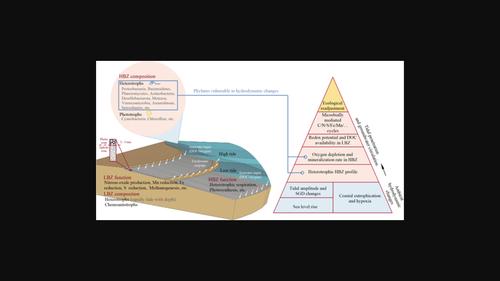当前位置:
X-MOL 学术
›
Hydrol. Process.
›
论文详情
Our official English website, www.x-mol.net, welcomes your feedback! (Note: you will need to create a separate account there.)
Zonations and oscillations via heterotrophic processes in tidal unvegetated aquifers
Hydrological Processes ( IF 3.2 ) Pub Date : 2022-07-24 , DOI: 10.1002/hyp.14654 Yuting Yao 1 , Jun Kong 1 , Chenming Zhang 2 , Zixuan Tang 3 , Chengji Shen 1 , Zhaoyang Luo 4 , Chunhui Lu 1 , Xuejun Feng 1 , Yang Sun 1
Hydrological Processes ( IF 3.2 ) Pub Date : 2022-07-24 , DOI: 10.1002/hyp.14654 Yuting Yao 1 , Jun Kong 1 , Chenming Zhang 2 , Zixuan Tang 3 , Chengji Shen 1 , Zhaoyang Luo 4 , Chunhui Lu 1 , Xuejun Feng 1 , Yang Sun 1
Affiliation

|
Global-change drivers that alter tidal amplitude or sea level could directly impact coastal aquifers' seawater–microbe interactions. The semidiurnal or diurnal tide can have consequences for chemical redistribution, because it deepens oxygen and nutrients penetration depth, thereby increasing O2 depletion via microbial respiration in sediments during groundwater circulation. However, chemical and microbial distributions in tidal aquifers remain unclear, in deference to their link with depth and lateral location. By combining the microbes-accumulated equation with the traditional groundwater flow model in coastal aquifers, we explicitly unravelled the heterotrophic zonation, the salinity zonation, and the oxic zonation of tidal aquifers. According to the model estimates, salt penetrates deeper than reactive chemicals, and the heterotrophic high biomass zone is presumably 2–3 m deep. Such depth of heterotrophic distribution is 2–3 orders of magnitude higher than phototrophic distribution. Additionally, heterotrophic biomass can exhibit faint oscillations, even under the tide forces, whereas dissolved chemicals fluctuate significantly with tidal pumps. Due to the transport of nutrients by tidal penetration, intertidal sediments have a higher respiration rate than subtidal sediments, converting more organic carbon from seawater to atmospheric CO2 via microbes. We demonstrate that heterotrophic biomass may play the dominant role in the chemical reactions of nearshore sediments. Our results confirm the efficacy of unvegetated tidal sediments that rely on ubiquitous heterotrophs as a driver of oxygen consumption and DOC transformation. These steps above will allow for better field investigations of coastal aquifers within a framework of zonations and oscillations.
中文翻译:

潮汐无植被含水层异养过程的分区和振荡
改变潮汐幅度或海平面的全球变化驱动因素可能直接影响沿海含水层的海水-微生物相互作用。半日潮或日潮会对化学物质再分配产生影响,因为它加深了氧气和营养物质的渗透深度,从而增加了 O 2在地下水循环过程中通过沉积物中的微生物呼吸消耗。然而,潮汐含水层中的化学和微生物分布仍不清楚,因为它们与深度和横向位置有关。通过将微生物累积方程与传统的沿海含水层地下水流动模型相结合,我们明确地揭示了潮汐含水层的异养分带、盐度分带和好氧分带。根据模型估计,盐比活性化学物质渗透得更深,异养高生物量区大概有 2-3 m 深。这种异养分布的深度比光养分布高2-3个数量级。此外,即使在潮汐力下,异养生物量也会表现出微弱的振荡,而溶解的化学物质会随着潮汐泵而显着波动。由于潮汐渗透输送养分,潮间带沉积物比潮下带沉积物具有更高的呼吸速率,将更多的有机碳从海水转化为大气 CO2通过微生物。我们证明异养生物质可能在近岸沉积物的化学反应中起主导作用。我们的结果证实了依赖无处不在的异养生物作为耗氧量和 DOC 转化驱动力的无植被潮汐沉积物的功效。上述这些步骤将允许在分区和振荡的框架内更好地对沿海含水层进行实地调查。
更新日期:2022-07-24
中文翻译:

潮汐无植被含水层异养过程的分区和振荡
改变潮汐幅度或海平面的全球变化驱动因素可能直接影响沿海含水层的海水-微生物相互作用。半日潮或日潮会对化学物质再分配产生影响,因为它加深了氧气和营养物质的渗透深度,从而增加了 O 2在地下水循环过程中通过沉积物中的微生物呼吸消耗。然而,潮汐含水层中的化学和微生物分布仍不清楚,因为它们与深度和横向位置有关。通过将微生物累积方程与传统的沿海含水层地下水流动模型相结合,我们明确地揭示了潮汐含水层的异养分带、盐度分带和好氧分带。根据模型估计,盐比活性化学物质渗透得更深,异养高生物量区大概有 2-3 m 深。这种异养分布的深度比光养分布高2-3个数量级。此外,即使在潮汐力下,异养生物量也会表现出微弱的振荡,而溶解的化学物质会随着潮汐泵而显着波动。由于潮汐渗透输送养分,潮间带沉积物比潮下带沉积物具有更高的呼吸速率,将更多的有机碳从海水转化为大气 CO2通过微生物。我们证明异养生物质可能在近岸沉积物的化学反应中起主导作用。我们的结果证实了依赖无处不在的异养生物作为耗氧量和 DOC 转化驱动力的无植被潮汐沉积物的功效。上述这些步骤将允许在分区和振荡的框架内更好地对沿海含水层进行实地调查。



























 京公网安备 11010802027423号
京公网安备 11010802027423号